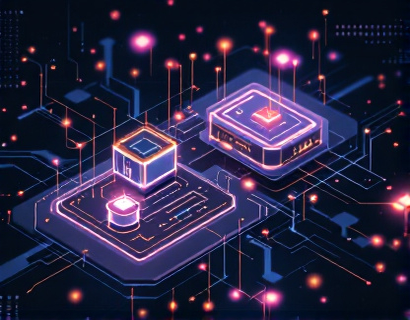Mastering Digital Currency Creation: A Guide to Cutting-Edge Software for Businesses and Blockchain Innovators
In the rapidly evolving landscape of blockchain technology, the ability to create and manage digital currencies has become an essential skill for businesses and innovators. This guide delves into the intricacies of using advanced software to master digital currency creation, focusing on customization, security, and scalability. By leveraging cutting-edge tools, both novices and experts can navigate the complexities of blockchain with confidence and ease.
Understanding Digital Currency Creation
Digital currencies, also known as cryptocurrencies, operate on blockchain technology, a decentralized ledger that records transactions across multiple computers. Creating a digital currency involves several steps, from designing the token's specifications to deploying it on a blockchain network. The process can be daunting, but with the right software, it becomes more manageable and accessible.
Key Features of Advanced Digital Currency Software
Modern software for digital currency creation offers a suite of features designed to simplify and enhance the development process. These features include:
- Customizable Token Parameters: Define the unique characteristics of your digital currency, such as total supply, decay rate, and reward mechanisms.
- Robust Security Protocols: Ensure the integrity and safety of your currency through advanced cryptographic techniques and secure coding practices.
- Seamless Integration: Easily integrate your digital currency with existing blockchain platforms and ecosystems.
- Scalability Solutions: Design your currency to handle increasing transaction volumes and user growth without compromising performance.
- User-Friendly Interfaces: Intuitive dashboards and tools that make it easy for users of all skill levels to manage and monitor their digital assets.
Customization Options
One of the most significant advantages of using advanced software for digital currency creation is the level of customization it offers. Here are some key aspects that can be tailored to meet specific business needs:
Token Structure: Define the type of token, such as utility tokens, security tokens, or stablecoins, each with different use cases and regulatory considerations.
Supply and Distribution: Set the total number of tokens, initial distribution methods, and mechanisms for future issuance or burning.
Consensus Mechanisms: Choose from various consensus algorithms like Proof of Work, Proof of Stake, or Delegated Proof of Stake to determine how transactions are validated and blocks are added to the blockchain.
Smart Contract Support: Incorporate smart contracts to automate and enforce complex business logic, enhancing the functionality and utility of your digital currency.
Security Considerations
Security is paramount in the world of digital currencies. Advanced software addresses this by implementing several critical security features:
Code Audits: Regular audits by independent security experts to identify and rectify vulnerabilities in the code.
Multi-Signature Wallets: Enhance transaction security by requiring multiple approvals for significant operations.
Hard Fork Protection: Implement mechanisms to protect against unintended or malicious hard forks that could disrupt the blockchain.
Privacy Features: Incorporate privacy-enhancing technologies to protect user data and transactions from unauthorized access.
Scalability and Performance
As the user base grows, the digital currency must scale efficiently to handle increased demand. Advanced software addresses scalability through:
Sharding: Divide the blockchain into smaller, manageable parts to process transactions in parallel, improving throughput.
Layer 2 Solutions: Utilize off-chain transactions to reduce load on the main blockchain, enhancing speed and reducing costs.
Optimized Consensus Algorithms: Employ efficient consensus mechanisms that balance security with high transaction processing rates.
Cloud Integration: Leverage cloud infrastructure to dynamically scale resources based on real-time demand.
User Experience and Accessibility
To broaden adoption, digital currency software must prioritize user experience and accessibility. Key features include:
Intuitive Dashboards: Provide clear and concise interfaces for users to manage their tokens and monitor network activity.
Comprehensive Documentation: Offer detailed guides and tutorials to help users understand and utilize the full range of features.
Multi-Language Support: Make the software accessible to a global audience by supporting multiple languages.
Mobile Compatibility: Ensure that the user interface is responsive and functional on various devices, including smartphones and tablets.
Case Studies and Success Stories
Several businesses and projects have successfully utilized advanced digital currency software to launch and manage their own tokens. For instance, a decentralized finance (DeFi) platform used the software to create a stablecoin with automated rebalancing features, significantly reducing volatility and enhancing user trust. Another example is a gaming company that integrated a utility token into their ecosystem, allowing players to earn and trade in-game assets, thereby creating a vibrant and engaged community.
Future Trends in Digital Currency Creation
The landscape of digital currency creation is continually evolving, driven by technological advancements and changing market demands. Some emerging trends include:
Interoperability: Developing tokens that can seamlessly interact with multiple blockchain networks, expanding their utility and reach.
Environmental Sustainability: Focusing on energy-efficient consensus mechanisms to reduce the environmental impact of blockchain operations.
Regulatory Compliance: Creating tools that help developers navigate complex regulatory landscapes and ensure compliance with local laws.
Decentralized Finance (DeFi) Integration: Enhancing digital currencies with DeFi features to offer a broader range of financial services.
Conclusion
Mastering digital currency creation is no longer the domain of tech experts alone. With advanced software designed for customization, security, and scalability, businesses and blockchain innovators can confidently enter the space and develop tokens that meet their unique needs. By leveraging these tools, the future of digital currencies looks promising, with endless possibilities for innovation and growth.










































